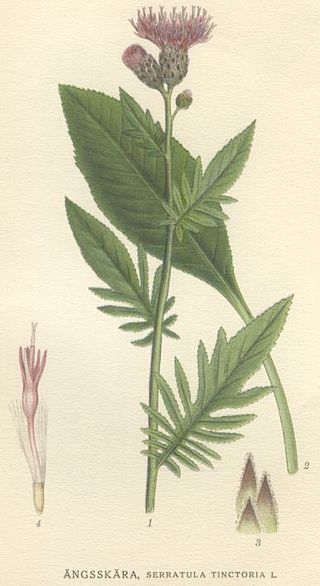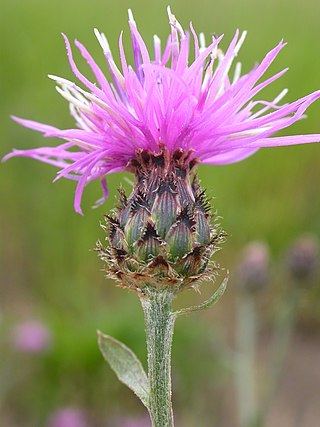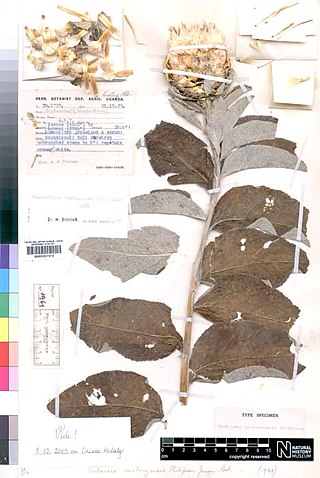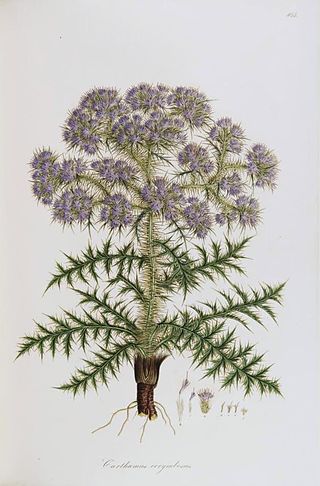
The Cardueae are a tribe of flowering plants in the daisy family (Asteraceae) and the subfamily Carduoideae. Most of them are commonly known as thistles; four of the best known genera are Carduus, Cynara, Cirsium, and Onopordum.

Rhaponticum is a genus of flowering plants in the tribe Cardueae within the family Asteraceae. As of November 2023, it is accepted by Plants of the World Online, but rejected by the Global Compositae Database in favour of Leuzea.

Serratula is a genus of plants in the tribe Cardueae within the family Asteraceae native to Eurasia. Plumeless saw-wort is a common name for plants in this genus. Serratula as traditionally defined contains at least two groups: one of which is basal within the subtribe Centaureinae and one of which is derived; the former group can be moved to the genus Klasea.
Centaurodendron is a genus of flowering plant in the tribe Cardueae within the family Asteraceae. The entire genus is endemic to the Juan Fernández Islands in the southern Pacific Ocean, part of the Republic of Chile.

The genus Cousinia of the tribe Cardueae is in its current circumscription one of the larger genera in the Asteraceae, with approximately 650-700 described species distributed in central and western Asia.

Carduoideae is the thistle subfamily of the Asteraceae, or sunflower family, of flowering plants. It comprises a number of tribes in various circumscriptions of the family, in addition to the Cardueae.

Echinops sphaerocephalus, known by the common names glandular globe-thistle, great globe-thistle or pale globe-thistle, is a Eurasian species of globe-thistle belonging to the tribe Cardueae within the family Asteraceae.
Oligochaeta is a genus of Asian flowering plants in the tribe Cardueae within the family Asteraceae.

Warionia is a genus in the tribe Cichorieae within the family Asteraceae. The only known species is Warionia saharae, an endemic of Algeria and Morocco, and it is locally known in the Berber language as afessas, abessas or tazart n-îfiss. It is an aromatic, thistle-like shrub of ½–2 m high, that contains a white latex, and has fleshy, pinnately divided, wavy leaves. It is not thorny or prickly. The aggregate flower heads contain yellow disk florets. It flowers from April till June. Because Warionia is deviant in many respects from any other Asteraceae, different scholars have placed it hesitantly in the Cardueae, Gundelieae, Mutisieae, but now genetic analysis positions it as the sister group to all other Cichorieae.
Siebera is a genus of flowering plants in the tribe Cardueae within the family Asteraceae which found in south western Asia.

Ochrocephala is a genus of Ethiopian flowering plants in the tribe Cardueae within the daisy family Asteraceae. Its only known species is Ochrocephala imatongensis, native to Ethiopia.

Picnomon is a genus of flowering plants in the tribe Cardueae within the family Asteraceae. The only known species is Picnomon acarna, native to Europe, Asia, and Africa from Portugal and the Canary Islands to Kazakhstan.
Callicephalus is a monotypic genus of flowering plants in the family Asteraceae, containing the single species Callicephalus nitens. It is native to the middle and low mountains of the Caucasus, where it has been recorded in Armenia, Azerbaijan, Georgia, Russia, and Turkey.

Cardopatium is a genus of flowering plants in the tribe Cardueae within the family Asteraceae. They are native to the central and eastern Mediterranean region.

Carduncellus is a genus of flowering plants in the tribe Cardueae within the family Asteraceae. They are native to the western Mediterranean and surrounding regions.
Cirsium kamtschaticum, the Kamchatka thistle, is an Alaskan and East Asian species of plants in the tribe Cardueae within the family Asteraceae. The species is found in eastern Russia, and on certain islands of the North Pacific: the Aleutian Islands of Alaska and Hokkaido Island in northern Japan.

Echinops spinosissimus is a European species of plant in the tribe Cardueae within the family Asteraceae. It is native to southeastern Europe, northern Africa, and southwest Asia as far east as Iran.

Klasea pusilla, is a species of flowering plant in the genus Klasea within the family Asteraceae. It is a native of the Eastern Mediterranean region.
Jurinea akinfievii, the Akinfiev's jurinea, is a herbaceous plant, a member of the tribe Cardueae within the Asteraceae family.

Echinops sahyadricus, the Sahyadri globe thistle, is a species of flowering plant. It is a medium sized forb belong to the tribe Cardueae in the family Asteraceae. E. sahyadricus was discovered by a Mumbai University student at the Rajgad Fort, and it was formally described in 2020.














